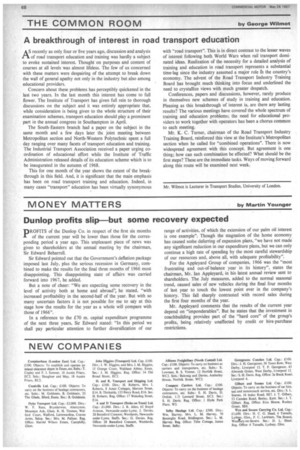THE COMMON ROOM by George Wilmot
Page 70

If you've noticed an error in this article please click here to report it so we can fix it.
A breakthrough of interest in road transport education
A S recently as only four or five years ago, discussion and analysis
of road transport education and training was hardly a subject to evoke sustained interest. Thought on purposes and content of courses at all levels was almost lifeless. The few of us concerned with these matters were despairing of the attempt to break down the wall of general apathy not only in the industry but also among educational providers.
Concern about these problems has perceptibly quickened in the last two years. In the last month this interest has come to full flower. The Institute of Transport has given full rein to thorough discussions on the subject and it was entirely appropriate that, while consideration is being given to the whole structure of their examination schemes, transport education should play a prominent part in the annual congress in Southampton in April.
The South-Eastern branch had a paper on the subject in the same month and a few days later thc joint meeting between Metropolitan section and North-Western Polytechnic spent a full day ranging over many facets of transport education and training. The Industrial Transport Association received a paper urging coordination of educational effort while the Institute of Traffic Administration released details of its education scheme which is to be inaugurated in the autumn of 1968.
This for one month of the year shows the extent of the breakthrough in this field. And, it is significant that the main emphasis has been on road transport training and education. Indeed, in many cases "transport" education has been virtually synonymous with "road transport". This is in direct contrast to the lesser waves of interest following both World Wars when rail transport dominated ideas. Realization of the necessity for a detailed analysis of training and education in road transport represents a substantial time-lag since the industry assumed a major role in the country's economy. The advent of the Road Transport Industry Training Board has brought much thinking into focus and underlined the need to crystallize views with much greater despatch.
Conferences, papers and discussions, however, rarely produce in themselves new schemes of study in training and education. Pleasing as this breakthrough of interest is, are there any lasting results? The various meetings have covered the whole spectrum of training and education problems; the need for educational providers to work together with operators has been a chorus common to each meeting.
Mr. K. C. Turner, chairman of the Road Transport Industry Training Board, reinforced this view at the Institute's Metropolitan section when he called for "combined operations". There is now widespread agreement with this concept. But agreement is one thing; how can such combination be effected? What should be the first steps? These are the immediate tasks. Ways of moving forward along this route will be examined next week.
Mr. Wilmot is Lecturer in Transport Studies, University of London.












































































































